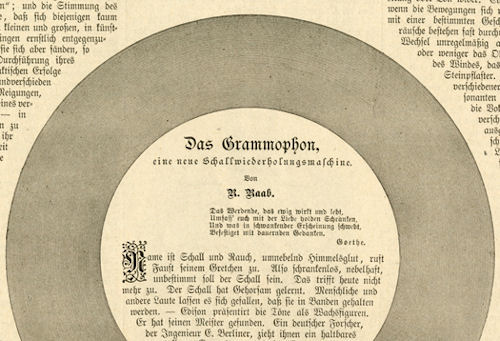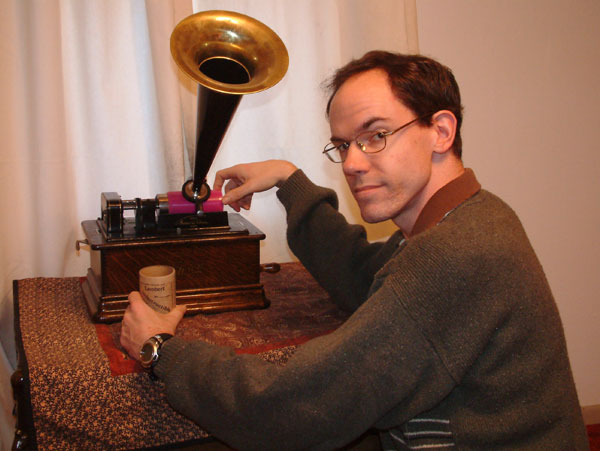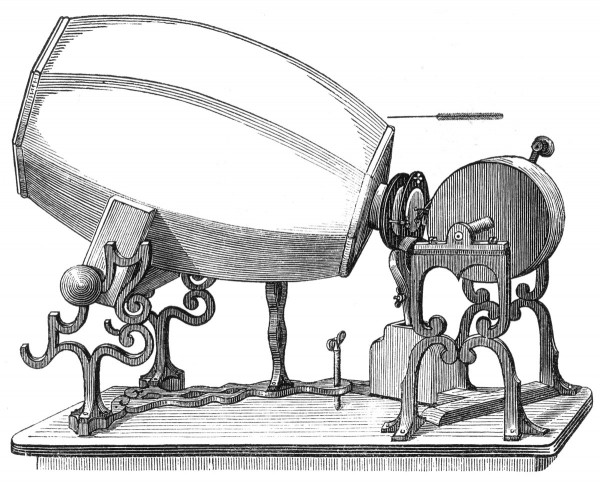Patrick Feaster, Sound Historian
Source: http://gizmodo.com/5922410/this-is-the-oldest-vinyl-album-in-the-history-of-the-world

Patrick Feaster, a sound historian at Indiana University, recreated an ~1889 Emile Berliner gramophone recording using a photograph of the album. Feaster found the photo of the album by chance, in a German magazine from 1890 stored at Bloomington's Herman B Wells Library: "I was looking for a picture of the oldest known recording studio, to illustrate a discussion I was giving on my work with Thomas Edison's recordings. I pulled it off the shelf and, while I had it open, I looked at the index and saw there was an article on the gramophone. I thought, 'Oh, that's a bonus'. So I flipped through and, lo and behold, there's a paper print of the actual recording."
Historians have found that the microscopic grooves on a bent metal ring, which was found in Thomas Edison's laboratory, make up the tune of 'Twinkle, Twinkle, Little Star' and mark the world's first attempt at a talking doll and the dawn of America's recording industry. Using advanced imaging technology they have recovered a 12 second sound recording of woman reciting a verse of the children's song. They believe the tin ring was intended to be the key component of one of Thomas Edison's talking dolls.
Historians think Edison hired the woman to make the recording less than two years before he unsuccessfully put the first talking doll on the market. 'Based on the date of fall 1888, it is the oldest American-made recording of a woman's voice that we can listen to today,' said Patrick Feaster, a historian at Indiana University in Bloomington. Mr Feaster pored over historical documents and 19th-century newspaper reports to piece together the story behind the recording.
Edison hoped to mass-produce the toys, but the era's rudimentary technology meant that to make 100 dolls, Edison would have to get artists to recite the lullaby 100 times. 'They must have been hired and paid to do this,' Mr Feaster said. 'These were presumably the first professional recording artists.' The small piece of ring-shaped tin bearing the woman's voice never made it into a doll because wax records replaced metal ones by 1890, when Edison started selling his first talking dolls. Those fragile and easily broken toys were a market flop.

Source: http://gizmodo.com/5922410/this-is-the-oldest-vinyl-album-in-the-history-of-the-world
RECENT POSTS
- Adding Background Music to Puzzlescript Games
- Baby Zombie Chicken Jockey Java Minecraft Mod
- Raining Chickens Java Minecraft Mod
- Spawn a Pet Wolf Java Minecraft Mod
- Spigot Server for Java Minecraft Mods
- Python Classes to Javascript Classes
- JUnit Tests with Repl.it Teams for Education
- Canvas How to convert an old Quiz Question Bank to a new Quiz Item Bank
- Node Twitterbot Directions
- FogeyBot Thinks Twitter is the Worst
- Detecting Sentence Structure with Regex
- Game-based Learning Presentation
- Hello Jekyll
- Testing 123
- Grading Multi-Select Questions with Google Forms and Google Sheets
- Puzzlescript Rules
- Using Makey Makey to Teach Electricity
- Makey Makey + Scratch Video Game Projects
- Orbit Simulator
- Market game
- TwineFray: A Battle System for Twine
- Sundown
- Twine Games by Middle School Students
- Twine CSS
- Twine Music and Sound Effects from YouTube
- Twine Pictures, GIFs, and Background Images
- Twine Random Numbers
- Tutorial videos for Spreadsheet Functions and Formulas
- How to Program Twitterbots as an Intro to Computer Science
- Podcast Recommendations
- Coding Twitterbots with Middle School Students
- Educational Games on The Internet Archive
- Typing Games in Scratch
- Scratch Tutorial Videos
- Editing videos with Windows Movie Maker
- How to use iMovie for iPad
- Quick and easy DIY pressure plate switch for Makey Makey and Scratch
- Webcam Motion Pixel Art
- Flipped Classroom Scratch Programming Lessons
- BYOD Music Class Using OhioFi Games
- 3 Methods for Going Paperless in the Classroom
- Dodgeball Cat
- How to Automatically Republish a Google Forms Spreadsheet
- The Funeral, a comedy...? by Jon Kovach
- Polaroid cameras that use Fuji Packfilm
- How to Use Google Drive to Store High Scores for Twine Games
- Twine scripts and macros
- Twine style
- Twine logic
- Twine variables

